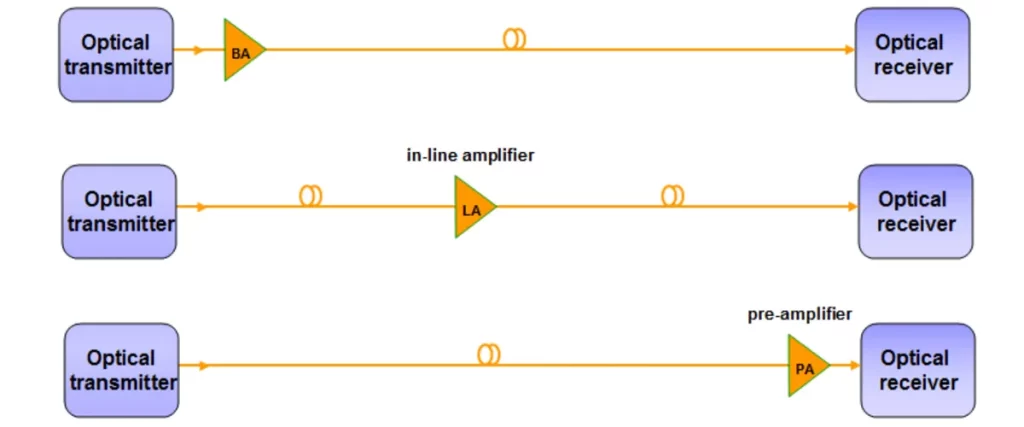Dense Wavelength Division Multiplexing (DWDM) systems are a crucial part of modern optical communication networks, with the core function of transmitting different wavelengths of light signals through the same optical fiber, significantly increasing communication capacity. In DWDM systems, optical amplifiers (OAs) play an essential role in compensating for signal loss over long-distance transmission, ensuring signal quality. There are three main types of optical amplifiers: Pre-Amplifiers (PA), Line Amplifiers (LA), and Booster Amplifiers (BA). This article will detail the roles and technical characteristics of these three types of optical amplifiers in DWDM systems.
Pre-Amplifier (PA)
Pre-Amplifiers are primarily used at the receiving end to amplify weak signals transmitted through the optical fiber. Their main function is to increase the power of the received signal to meet the input requirements of the optical detector, thereby improving the Signal-to-Noise Ratio (SNR) at the receiving end. Pre-Amplifiers typically use Erbium-Doped Fiber Amplifier (EDFA) technology, which amplifies signals in the 1550nm band through optical fibers doped with erbium ions, excited by 980nm or 1480nm pump light. Since PAs are located at the receiving end, noise control is critical, requiring designs that balance low noise and high gain.
Line Amplifier (LA)
Line Amplifiers are mainly used in the relay segments of the optical fiber transmission link to compensate for signal loss over long distances. Their role is to ensure that the optical signal maintains sufficient strength and quality after traveling hundreds of kilometers of optical fiber. The core technology of Line Amplifiers is also EDFA. However, to cope with the complex environments of long-distance transmission, Line Amplifiers are typically designed with multiple cascaded amplifiers to increase total gain and output power. Additionally, Line Amplifiers must have Automatic Gain Control (AGC) and Automatic Power Control (APC) functions to adapt to varying transmission distances and signal strength changes.
Booster Amplifier (BA)
Booster Amplifiers are located at the transmitting end and primarily function to amplify the low-power signals generated by optical transmission equipment to the higher power levels required by the transmission fiber. Booster Amplifiers are used to compensate for insertion loss from transmission equipment and optical connectors, ensuring the output signal has sufficient power and quality. Unlike PAs and LAs, Booster Amplifiers focus more on output power and stability, requiring designs that balance high output power and effective heat dissipation. To reduce the impact of nonlinear effects on the signal, Booster Amplifiers typically use multi-stage amplification and gain equalization technologies.
Key Technologies of Optical Amplifiers
The core technologies of optical amplifiers are concentrated in gain medium, pump excitation, and noise control. Taking EDFA as an example, its gain medium is erbium-doped fiber, which amplifies signals in the 1550nm band through excitation by 980nm or 1480nm pump light. To improve the efficiency and performance of amplifiers, multi-stage pumping and gain equalization techniques are often employed to optimize output power and gain flatness.
Noise control is a significant challenge in the design of optical amplifiers. While amplifying signals, optical amplifiers also amplify noise, particularly in pre-amplifiers, where the noise figure directly affects the quality of the received signal. To reduce noise, optical amplifiers typically use low-noise amplifier designs and optimize the selection of pump light sources and gain media.
As a leader in the optical communication field, HTF has significant advantages in optical amplifier technology. HTF‘s optical amplifiers use advanced erbium-doped fiber technology and multi-stage pumping designs, characterized by high gain, low noise, and high stability. HTF emphasizes technological innovation and product quality, with its optical amplifier products widely used in global optical communication networks, earning the trust of users. With its excellent technological capabilities and quality service, HTF has established a strong brand image in the industry, continuously leading the development of optical communication technology.



